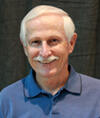In The News: Department of Geoscience

On a day about 313 million years ago, a four-legged animal took a stroll up the slope of a sand dune, leaving only footprints behind.
Paleontological research has confirmed a series of recently discovered fossils tracks are the oldest recorded tracks of their kind to date within Grand Canyon National Park. In 2016, Norwegian geology professor, Allan Krill, was hiking with his students when he made a surprising discovery. Lying next to the trail, in plain view of the many hikers, was a boulder containing conspicuous fossil footprints. Krill was intrigued, and he sent a photo to his colleague, Stephen Rowland, a paleontologist at the University of Nevada Las Vegas.
Fossilized footprints discovered in Grand Canyon National Park were confirmed by paleontologists on Friday to be the oldest recorded tracks of their kind.

Some 313 million years ago, two creatures trekked across sand dunes in what is now the Grand Canyon and now paleontologist have uncovered evidence of their journey.

Finding fossil footprints at the Grand Canyon isn't particularly unusual. The expansive stretch of red rock is home to an array of formations containing preserved remains of the past.
Researchers have discovered that fossil footprints found at the Grand Canyon are the oldest tracks of their kind to date in the area.
A new chapter to Grand Canyon National Park's geologic past has come to light in the unique form of two sets of fossilized tracks more than 300 million years old that are lying in view of any hiker on the Bright Angel Trail. Those tracks, according to paleontologists, "are by far the oldest vertebrate tracks in Grand Canyon."
Caves in Nevada can tell scientists about the history of the climate in the West and what it might look like in the future.

Tom Gordon of Carson City didn’t expect his backyard to become an excavation site when he starting planting trees this summer, but that’s what happened after he found what looked like an animal graveyard.

Tom Gordon of Carson City didn’t expect his backyard to become an excavation site when he starting planting trees this summer, but that’s what happened after he found what looked like an animal graveyard.

Steve Rowland, paleontologist and professor of geology at UNLV, discusses the Ice Age fossils recently extracted from private property in Carson City, at the Las Vegas Natural History Museum in Las Vegas.

In response to your July 27 story, “New study may predict ‘worst case’ climate scenario for Nevada’”: I read this report with alarm. Every disaster movie starts with a scientific warning being ignored, and we ignore this study at our peril. Like ignoring the early coronavirus warnings, not following advice from climate scientists creates disasters, too.

